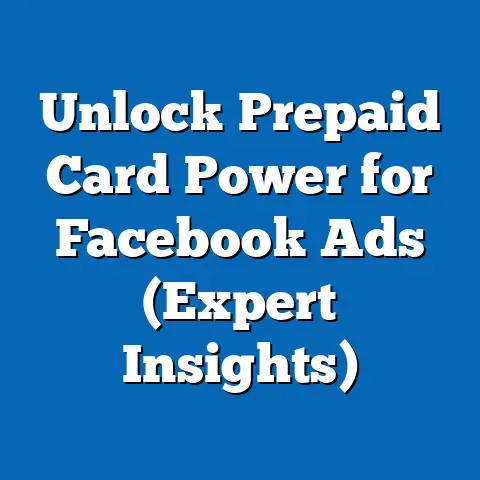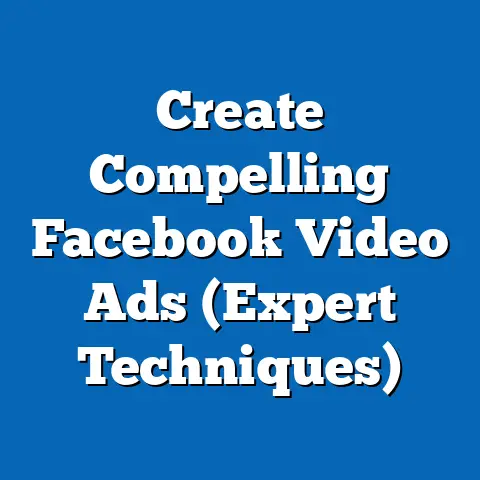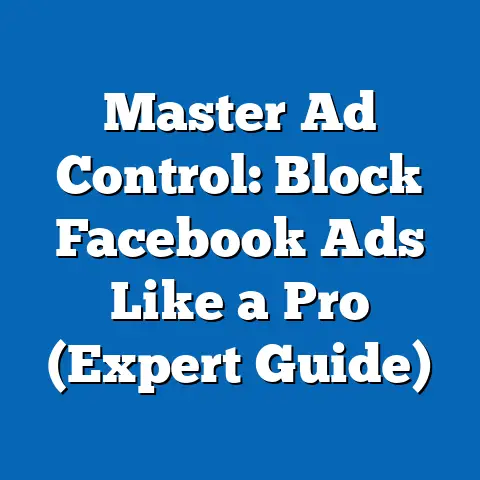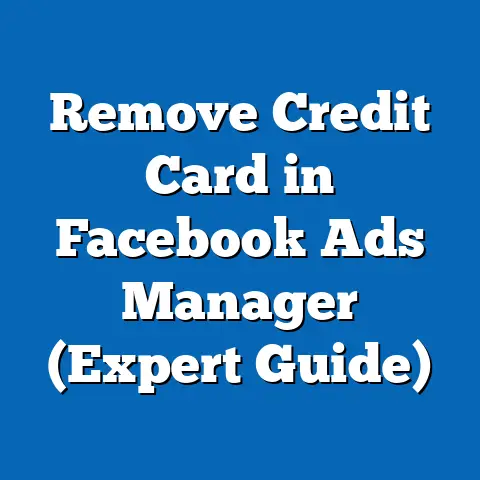Troubleshooting Facebook Ad Rejections (Expert Solutions)
Facebook advertising. It’s the lifeblood of many businesses today, a digital megaphone capable of reaching billions with targeted messages. I’ve seen firsthand how a well-crafted Facebook ad can transform a struggling business into a thriving one. But what happens when your carefully designed ad gets rejected? It’s not just frustrating; it can derail your entire marketing strategy, costing you time, money, and potential customers.
I remember one instance where a client, a local bakery, was launching a new line of vegan pastries. Their ads were stunning, showcasing delicious-looking treats. We’d poured hours into crafting the perfect copy and targeting the right audience. But every single ad was rejected. We were baffled. It turned out, the issue was a minor, unintentional violation of Facebook’s policy regarding health claims. It was a hard lesson learned, and it highlighted the importance of understanding Facebook’s intricate web of advertising guidelines.
Ad rejection is a common pain point for marketers. It can feel like navigating a minefield, especially with Facebook’s ever-evolving policies. According to recent statistics, a significant percentage of Facebook ads are rejected each year, primarily due to policy violations. This isn’t just a minor inconvenience; it directly impacts your campaign effectiveness and, ultimately, your business growth.
Understanding Facebook’s Ad Policies
At the heart of successful Facebook advertising lies a deep understanding of the platform’s advertising policies and community standards. Think of these policies as the rulebook for playing the Facebook ad game. Adhering to them isn’t just a suggestion; it’s a necessity. Violations can lead to ad rejections, account suspensions, and even permanent bans from the platform.
Facebook’s ad policies are designed to protect users from misleading, offensive, or harmful content. They cover a wide range of topics, including:
- Prohibited Content: This includes content that promotes illegal activities, discrimination, hate speech, violence, or the sale of regulated products like drugs and firearms.
- Restricted Content: This category covers content that requires special authorization or is subject to certain limitations. Examples include ads for alcohol, gambling, dating services, and financial products.
- Personal Attributes: Ads must not directly or indirectly assert or imply personal attributes such as race, ethnicity, religion, age, sexual orientation, gender identity, disability, or medical condition.
- Misleading or Deceptive Practices: Ads must be truthful and accurate. They cannot make false claims, use deceptive imagery, or conceal information.
- Data Collection and Use: Ads must comply with Facebook’s data privacy policies and obtain user consent when collecting personal information.
- Grammar and Profanity: Ads should follow proper grammar, spelling, and punctuation rules. Profanity and offensive language are prohibited.
One common misconception is that only overtly offensive ads get rejected. In reality, even subtle violations can trigger the algorithm. For instance, an ad promoting weight loss products that makes exaggerated claims about results could be flagged for misleading information. Similarly, an ad targeting a specific age group with language that directly implies their age might violate the policy against personal attributes.
I’ve seen countless examples of ads that were rejected due to seemingly minor violations. A client who sold educational toys had an ad rejected because the image featured a child without proper seatbelt safety in a car. Another client, a real estate agent, had an ad rejected for using language that implied knowledge of the user’s location without explicitly stating it.
Takeaway: Familiarize yourself with Facebook’s advertising policies and community standards. Pay close attention to the details and avoid making assumptions about what constitutes a violation. Regularly review the policies, as they are subject to change.
Common Reasons for Ad Rejection
Now that we’ve established the importance of understanding Facebook’s ad policies, let’s dive into the most common reasons why ads get rejected. Identifying these pitfalls can help you avoid them in the first place and save you valuable time and resources.
Here’s a breakdown of the most frequent culprits:
- Misleading or False Content: This is perhaps the most common reason for ad rejection. Facebook takes a strong stance against ads that make false claims, exaggerate benefits, or conceal information. For example, an ad claiming a product can “cure” a disease without scientific evidence would be rejected. Similarly, an ad offering a “free” product but requiring hidden fees or subscriptions would be flagged as misleading.
- Inappropriate Images or Videos: Visual content plays a crucial role in Facebook advertising, but it must adhere to strict guidelines. Ads featuring sexually suggestive content, violence, graphic imagery, or anything that violates community standards will be rejected. Even seemingly harmless images can be flagged if they are deemed offensive or inappropriate.
- Excessive Text in Images: Facebook prefers ads with minimal text in images. The “20% text rule” used to be a hard limit, but now Facebook uses a more nuanced approach. However, ads with excessive text may still experience reduced reach or be rejected altogether. Avoid using large blocks of text in your images and prioritize visually appealing content.
- Targeting Issues: Facebook’s targeting options are powerful, but they must be used responsibly. Ads that target specific groups based on sensitive personal attributes, such as race, ethnicity, religion, or sexual orientation, are prohibited. Additionally, ads that exploit vulnerable audiences, such as children or individuals with disabilities, will be rejected.
- Poor Grammar and Spelling: While seemingly trivial, poor grammar and spelling can significantly impact your ad’s credibility and lead to rejection. Facebook values professionalism and accuracy in advertising. Proofread your ad copy carefully and use grammar-checking tools to ensure your ads are error-free.
- Functionality Issues: Ads that lead to broken links, non-functional landing pages, or websites that violate Facebook’s terms of service will be rejected. Ensure your website is fully functional and compliant before running your ads.
- Promoting Prohibited Products or Services: As mentioned earlier, Facebook prohibits the promotion of certain products and services, including illegal drugs, firearms, and counterfeit goods. Attempting to advertise these items will result in immediate rejection and potential account suspension.
- Personal Health and Appearance Claims: Ads that make direct claims about a user’s personal health or appearance are often rejected. This includes ads that target users based on their weight, fitness level, or medical conditions. Avoid using language that implies you know something about the user’s personal attributes.
Real-World Examples:
- Rejection Reason: Misleading Content
- Ad: “Lose 20 pounds in 2 weeks with our revolutionary diet pill!”
- Analysis: This ad makes an unrealistic and unsubstantiated claim about weight loss, violating the policy against misleading content.
- Rejection Reason: Inappropriate Images
- Ad: Image featuring a person holding a weapon.
- Analysis: This ad violates the policy against promoting or depicting violence or dangerous items.
- Rejection Reason: Targeting Issues
- Ad: Targeting users “interested in Christian dating.”
- Analysis: This ad targets users based on their religious affiliation, violating the policy against targeting sensitive personal attributes.
- Ad: “Lose 20 pounds in 2 weeks with our revolutionary diet pill!”
- Analysis: This ad makes an unrealistic and unsubstantiated claim about weight loss, violating the policy against misleading content.
- Ad: Image featuring a person holding a weapon.
- Analysis: This ad violates the policy against promoting or depicting violence or dangerous items.
- Ad: Targeting users “interested in Christian dating.”
- Analysis: This ad targets users based on their religious affiliation, violating the policy against targeting sensitive personal attributes.
Takeaway: Carefully review your ad content, images, targeting options, and website to ensure compliance with Facebook’s advertising policies. Pay attention to the details and avoid making assumptions about what is acceptable.
Expert Troubleshooting Steps
So, your ad got rejected. Don’t panic! It happens to the best of us. The key is to approach the situation systematically and follow a clear troubleshooting process. Here’s a step-by-step guide to help you resolve ad rejections and get your campaigns back on track:
- Review Facebook’s Ad Policies: This may seem obvious, but it’s the most crucial step. Before doing anything else, revisit Facebook’s advertising policies and community standards. Pay close attention to the sections that are relevant to your ad’s content and targeting. Sometimes, a fresh perspective can help you identify potential violations you may have missed.
-
Analyze the Ad Content: Once you’ve reviewed the policies, carefully analyze your ad content, including the ad copy, images, videos, and landing page. Use the following checklist:
- Ad Copy: Is the language truthful, accurate, and non-misleading? Does it avoid making exaggerated claims or implying knowledge of the user’s personal attributes?
- Images/Videos: Are the visuals appropriate and non-offensive? Do they comply with Facebook’s guidelines regarding violence, nudity, and graphic content? Is the text-to-image ratio within acceptable limits?
- Landing Page: Is the landing page functional and compliant with Facebook’s terms of service? Does it provide a clear and accurate description of the product or service being advertised?
- Targeting: Are you targeting users based on sensitive personal attributes? Are you excluding any protected groups?
- Utilize Facebook’s Ad Preview Tool: Facebook’s Ad Preview tool allows you to visualize how your ad will appear on different devices and placements. This can help you identify potential issues with formatting, image quality, or text visibility. Use this tool to ensure your ad looks professional and compliant across all platforms.
- Make Necessary Revisions: Based on your analysis, make the necessary revisions to your ad content, targeting options, or landing page. Be specific and address the potential violations you’ve identified. For example, if your ad copy makes an exaggerated claim, revise it to be more accurate and realistic. If your image contains excessive text, reduce the amount of text or replace it with a different image.
- Resubmission Process: Once you’ve made the necessary revisions, resubmit your ad for review. In the Ads Manager, you should see a notification indicating that your ad was rejected. Click on the notification to view the reason for the rejection. You’ll have the option to edit the ad and resubmit it or appeal the decision. If you believe your ad was wrongly rejected, you can submit an appeal to Facebook’s review team. Explain why you believe your ad complies with the policies and provide any supporting documentation.
- Contact Facebook Support: If you’re still unsure why your ad was rejected or if you’ve exhausted all other troubleshooting options, contact Facebook Business Support for assistance. Be prepared to provide detailed information about your ad, including the ad ID, the reason for rejection, and any revisions you’ve made.
Analyze the Ad Content: Once you’ve reviewed the policies, carefully analyze your ad content, including the ad copy, images, videos, and landing page. Use the following checklist:
- Ad Copy: Is the language truthful, accurate, and non-misleading? Does it avoid making exaggerated claims or implying knowledge of the user’s personal attributes?
- Images/Videos: Are the visuals appropriate and non-offensive? Do they comply with Facebook’s guidelines regarding violence, nudity, and graphic content? Is the text-to-image ratio within acceptable limits?
- Landing Page: Is the landing page functional and compliant with Facebook’s terms of service? Does it provide a clear and accurate description of the product or service being advertised?
- Targeting: Are you targeting users based on sensitive personal attributes? Are you excluding any protected groups?
- Utilize Facebook’s Ad Preview Tool: Facebook’s Ad Preview tool allows you to visualize how your ad will appear on different devices and placements. This can help you identify potential issues with formatting, image quality, or text visibility. Use this tool to ensure your ad looks professional and compliant across all platforms.
- Make Necessary Revisions: Based on your analysis, make the necessary revisions to your ad content, targeting options, or landing page. Be specific and address the potential violations you’ve identified. For example, if your ad copy makes an exaggerated claim, revise it to be more accurate and realistic. If your image contains excessive text, reduce the amount of text or replace it with a different image.
- Resubmission Process: Once you’ve made the necessary revisions, resubmit your ad for review. In the Ads Manager, you should see a notification indicating that your ad was rejected. Click on the notification to view the reason for the rejection. You’ll have the option to edit the ad and resubmit it or appeal the decision. If you believe your ad was wrongly rejected, you can submit an appeal to Facebook’s review team. Explain why you believe your ad complies with the policies and provide any supporting documentation.
- Contact Facebook Support: If you’re still unsure why your ad was rejected or if you’ve exhausted all other troubleshooting options, contact Facebook Business Support for assistance. Be prepared to provide detailed information about your ad, including the ad ID, the reason for rejection, and any revisions you’ve made.
I’ve found that providing clear and concise information to Facebook support can significantly expedite the review process. Be polite, professional, and persistent. Remember, they’re there to help you.
Insights from Industry Experts:
“When crafting compliant ads, focus on providing value to your audience and building trust. Avoid using sensationalist language or making unrealistic promises. Transparency and authenticity are key.” – Sarah Johnson, Digital Marketing Consultant
“Before launching any ad campaign, create a checklist of potential policy violations and review your ad content against that checklist. This can help you identify and address issues before they lead to rejection.” – Michael Brown, Facebook Ads Specialist
Takeaway: Don’t give up after your ad gets rejected. Follow these troubleshooting steps systematically and leverage Facebook’s resources to resolve the issue.
Leveraging Facebook’s Resources
Facebook offers a wealth of resources to help advertisers avoid rejections and create successful campaigns. These resources can be invaluable in understanding the platform’s policies, troubleshooting issues, and staying up-to-date with the latest best practices.
Here are some of the most helpful resources:
- The Ads Help Center: The Ads Help Center is a comprehensive knowledge base that provides answers to common questions about Facebook advertising. It covers a wide range of topics, including ad policies, targeting options, ad formats, and reporting. Use the search function to find answers to specific questions or browse the articles by category.
- Facebook Business Support: Facebook Business Support provides personalized assistance to advertisers who need help with their campaigns. You can contact support via email, chat, or phone. Be prepared to provide detailed information about your ad, including the ad ID, the reason for rejection, and any revisions you’ve made.
- Community Forums and Groups: Numerous online communities and groups are dedicated to Facebook advertising. These forums can be a great place to ask questions, share experiences, and learn from other advertisers. Be sure to choose reputable and active communities with knowledgeable members.
- Facebook Blueprint: Facebook Blueprint is a free online learning platform that offers courses on various aspects of Facebook advertising. These courses cover topics such as ad policies, targeting, creative strategies, and campaign optimization. Completing Facebook Blueprint courses can help you gain a deeper understanding of the platform and improve your advertising skills.
- Facebook Newsroom: Stay up-to-date with the latest news and announcements from Facebook by following the Facebook Newsroom. This is where Facebook announces changes to its policies, features, and algorithms. Staying informed can help you adapt your advertising strategies to the ever-changing landscape.
Tips for Effectively Using Facebook’s Resources:
Takeaway: Don’t underestimate the power of Facebook’s resources. Leverage these tools to enhance your knowledge, troubleshoot issues, and stay ahead of the curve.
Preventative Measures for Future Campaigns
The best way to avoid Facebook ad rejections is to implement preventative measures in your future campaigns. By taking a proactive approach, you can minimize the risk of violations and ensure your ads are approved quickly and efficiently.
Here are some strategies you can implement:
- Develop a Compliance Checklist: Create a comprehensive checklist of potential policy violations based on your industry and target audience. Review your ad content, targeting options, and landing page against this checklist before launching any campaign.
- Conduct Thorough Competitor Analysis: Analyze your competitors’ ads to see what works and what doesn’t. Pay attention to the language they use, the images they feature, and the targeting options they employ. This can provide valuable insights into what is acceptable and what is not.
- Run A/B Tests on Ad Variations: Before launching a large-scale campaign, run A/B tests on different ad variations to determine which ones are most compliant and effective. Test different ad copy, images, and targeting options.
- Stay Updated with Policy Changes: Facebook’s advertising policies are subject to change. Regularly review the policies and stay informed about any updates or revisions.
- Use Facebook’s Ad Library: The Ad Library allows you to search for and view ads that are currently running on Facebook. This can be a valuable resource for identifying potential policy violations and learning from other advertisers’ mistakes.
- Seek Expert Advice: If you’re unsure about any aspect of Facebook advertising, seek advice from experienced professionals or consultants. They can provide valuable guidance and help you avoid costly mistakes.
I always advise my clients to err on the side of caution when it comes to compliance. It’s better to be safe than sorry. A few extra minutes spent reviewing your ads can save you hours of frustration and lost revenue.
Takeaway: Proactive planning and continuous learning are essential for minimizing the risk of Facebook ad rejections. Implement these preventative measures to ensure your campaigns are compliant and effective.
Conclusion
Facebook advertising is a powerful tool that can drive significant results for your business. However, navigating the platform’s complex advertising policies can be challenging. Ad rejections are a common frustration, but they don’t have to be a roadblock.
By understanding Facebook’s ad policies, identifying common reasons for rejection, following a clear troubleshooting process, leveraging Facebook’s resources, and implementing preventative measures, you can minimize the risk of violations and unlock your advertising potential.
Remember, ad rejections are not the end of the road. They are an opportunity to learn, adapt, and improve your advertising strategies. By taking a proactive and systematic approach, you can overcome these challenges and achieve success on the Facebook platform.
So, embrace the challenge, stay informed, and keep experimenting. With the knowledge and tools you’ve gained from this guide, you’re well-equipped to navigate the complexities of Facebook ad approval and achieve your advertising goals.
Now, I’d love to hear from you! What are your experiences with Facebook ad rejections? What tips or strategies have you found most helpful? Share your thoughts and insights in the comments below. And don’t forget to follow my blog for more insightful articles on digital marketing strategies.






